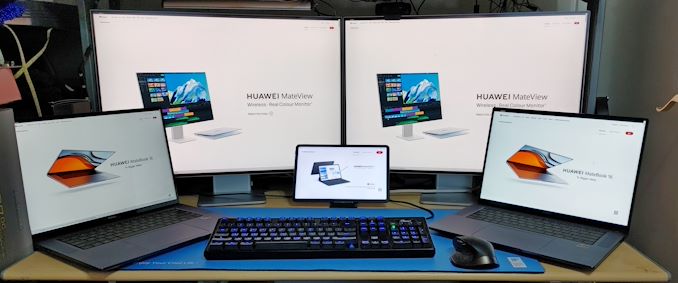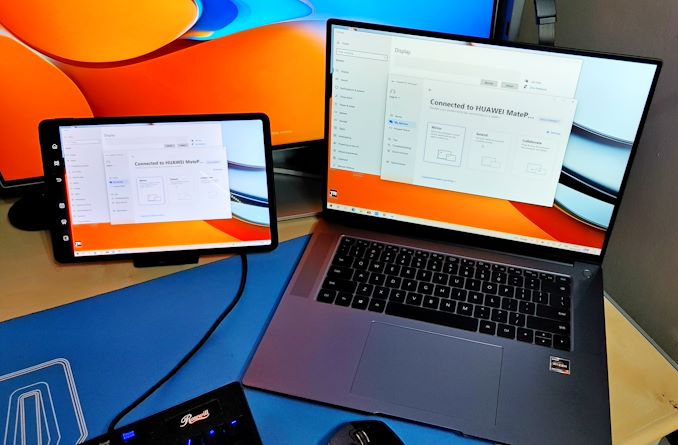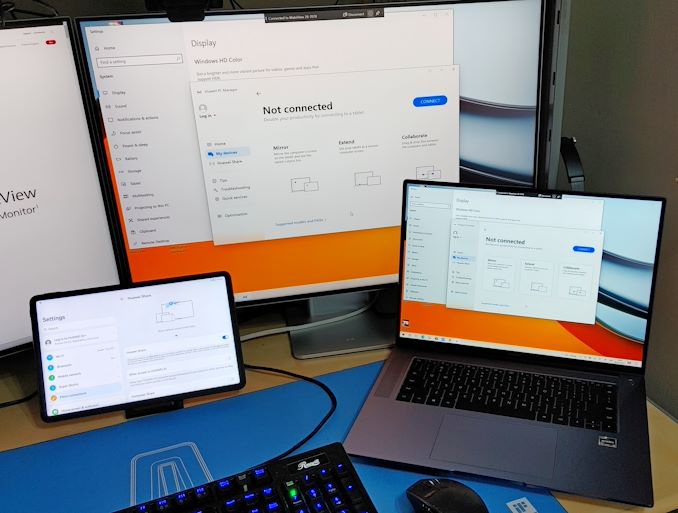The Huawei MateBook 16 Review, Powered by AMD Ryzen 7 5800H: Ecosystem Plus
by Dr. Ian Cutress on October 20, 2021 8:00 AM EST- Posted in
- Laptops
- AMD
- Huawei
- Matebook
- Ryzen
- Zen 3
- MateBook 16
- Huawei Share
- Ryzen 7 5800H
Huawei Share
For the last few generations, the Huawei Share utility was advertised as an easy way to transfer files between a Huawei smartphone and a Huawei laptop. By using the NFC sensor in the phone, and an NFC coil on the right side of the trackpad, a user could ideally wave their smartphone, and the requisite app would load on both devices asking to connect. This functionality eventually expanded to allow the smartphone display to show on the laptop, or the smartphone to be used as an additional touch screen/mouse control for the laptop.
That’s about where it stood before the company was put on the US Entity list. Since then, the opportunity to test the feature’s improvements has been few and far between, partly due to the confusion about where and when devices would come out, but also the global pandemic limited travel, product launches, and demonstrations. Fast forward to 2021, and Huawei’s device portfolio has expanded.
The most notable expansion in my eyes is a push into the monitor market. Huawei now sells two monitors: the MateView, a 28-inch HDR400 monitor at a 3:2 aspect ratio labeled as a 4K+ resolution (3840x2560), and the MateView GT, a 34-inch ultrawide monitor with a 3440x1440 resolution and 165 Hz refresh rate. Both monitors also feature an NFC coil in the base to use with Huawei Share, as well as an intuitive menu system to support wireless connectivity with any non-Huawei supporting device. The MateView displays were recently significantly discounted in the UK over September (£400 after rebate), and unbeknownst to the Huawei PR team here, I purchased two.
The PR team had sent over the latest Huawei Android Tablet, the MatePad 11, to test with Huawei Share. Put this all together, with my Huawei P30 Pro smartphone, and technically everything should work with everything else.
Connecting the laptop to either the smartphone or the tablet works through Huawei Share directly. The tablet allows for screen duplicate, screen expansion, or using the tablet as a mouse for the laptop. Connecting the smartphone shows the smartphone screen on the laptop, so it can be controlled with a mouse/keyboard, as well as take calls and tether to take advantage of any data/Wi-Fi. The laptop control of the smartphone allows for multiple smartphone apps to be open in separate windows, including video playback on YouTube, for example, however any audio played on the smartphone is redirected to the laptop instead.
Connecting to the monitor is slightly different, as it doesn’t go through Huawei Share. This is done with Windows’ own wireless display connectivity. Search for ‘connect to a wireless display’, and it goes through the motions. For some devices it requires activating a feature or two inside Windows, but it takes you through it step-by-step, and then after that it’s quite easy. That being said, there is a couple of drawbacks.
Connecting through Huawei Share is secure, and requires verification on both devices. Connecting to the wireless display does not, and so in an open office environment it requires the devices to be named, as you can take over someone’s device even when they are using it. Also, wireless display connectivity at a distance of 6 feet showcased a small but noticeable input lag. In this environment, the display is best for content that doesn’t require much interaction, such as a static calendar, or a film.
But on the plus side, even though Huawei Share is a single point-to-point connection, using the wireless display through Windows option doesn’t take that away, so you can connect to monitor+smartphone or monitor+tablet at the same time. With the HDMI port, there’s another option for a display, perhaps with better input lag as well. Although with all these displays, some being driven through the CPU rather than the GPU, it will start to put a load on the system.
As part of this review process, I ended up with two MateBook 16 devices. The charger on my first one was effectively DoA, so instead of sending me a separate 135W charger, the PR team just sent a full laptop. I was intrigued if I could connect both laptops together – and technically I could through the wireless display feature! While this is really quite pointless, it was a fun activity.
I would say that there is one limitation – I could only connect to one device through Huawei Share at a time. For example, I could not connect to the tablet and the smartphone at the same time – it was one or the other. This is likely down to only having one point-to-point connection available, as more would require battery/cost/weight. Ultimately at some point in Huawei’s future I imagine there to be a dock for multiple devices to be connected to, some wired, others wireless.














87 Comments
View All Comments
fishingbait15 - Friday, October 22, 2021 - link
Why shouldn't Huawei shamelessly copy Apple when Apple has been shamelessly copying Samsung for going on 10 years? Apple Watch? Samsung did it first. AirPods? Again, Samsung first. Apple invented the modern tablet, true, but the iPad Pro concept (oversized tablet with stylus and emphasis on detachable keyboard and multitasking in the OS) was done by the Samsung Galaxy Pro first. And again, Apple invented the iPhone, but every iPhone since 2011 has been a ripoff of the Samsung Galaxy line. Apple even copied the curved screen. Except that where Samsung actually had apps to take advantage of the curve, Apple merely copied the form without the function. And while Apple didn't copy Samsung with the Apple TV, Amazon and Google had their truly smart TV boxes first.Amazing how you guys never acknowledge Apple's blatant copying. Especially since even the Apple blogs acknowledge that Apple's latest Macs reject Jony Ive's minimalist philosophy in favor of designs more similar to what Dell and HP are doing.
vladx - Saturday, October 23, 2021 - link
Brainwashing tends to do that you.Oxford Guy - Sunday, October 24, 2021 - link
'Apple invented the iPhone, but'jcc5169 - Thursday, October 21, 2021 - link
Did you check them for spyware?Oxford Guy - Sunday, October 24, 2021 - link
Which spyware? OS? Black box CPUs within CPUs? Hidden stuff in other chips? Things added by various entities surreptitiously after the product leaves the factory in a box?Everything has spyware. Even the top-level internal use only stuff has it. It's just that those at the highest levels know about it (full documentation). Heads of state are surveilled by the agencies that ostensibly work for them, for instance.
Ruimanalmeida - Friday, October 22, 2021 - link
Those reading these comments could be interested on this review: https://www.notebookcheck.com/Huawei-MateBook-16-A...High reflective display...problematic on the move.
crunch418 - Monday, April 25, 2022 - link
<a href="https://kfc-breakfast-menu.website/"> KFC Breakfast Menu Prices </a>
KFC is a fast-food restaurant chain based in America, also known as Kentucky Fried Chicken. It is loved by people worldwide for its fried chicken.
KFC has become so successful worldwide due to the crispy and crunchy chicken products it serves, which no other restaurant chain has completed.